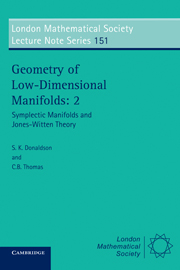Book contents
- Frontmatter
- Contents
- Contributors
- Names of Participants
- Introduction
- Acknowledgements
- PART 1 SYMPLECTIC GEOMETRY
- PART 2 JONES/WITTEN THEORY
- Introduction
- New results in Chern-Simons theory
- Geometric quantization of spaces of connections
- Evaluations of the 3-manifold invariants of Witten and Reshetikhin-Turaev for sl(2, C)
- Representations of braid groups
- PART 3 THREE-DIMENSIONAL MANIFOLDS
Introduction
Published online by Cambridge University Press: 01 June 2011
- Frontmatter
- Contents
- Contributors
- Names of Participants
- Introduction
- Acknowledgements
- PART 1 SYMPLECTIC GEOMETRY
- PART 2 JONES/WITTEN THEORY
- Introduction
- New results in Chern-Simons theory
- Geometric quantization of spaces of connections
- Evaluations of the 3-manifold invariants of Witten and Reshetikhin-Turaev for sl(2, C)
- Representations of braid groups
- PART 3 THREE-DIMENSIONAL MANIFOLDS
Summary
The discovery by Vaughan Jones of a new polynomial invariant of links in the 3-sphere was an important breakthrough which has lead to the introduction of a whole range of new techniques in 3-dimensional topology. The original Jones invariant, a Laurent polynomial in one variable, was obtained via a “braid” description of a link, utilising the remarkable properties of some representations of the braid group which arose in the theory of Von Neumann algebras. Early developments were largely combinatorial, leading to alternative definitions of the invariant and to generalisations, including a 2-variable polynomial which specialises to both the Jones polynomial and the classical Alexander polynomial after appropriate substitutions. The new invariants are comparatively easy to calculate and have had many concrete applications but for some time no really satisfactory conceptual definition of the invariants was known: one not relying on special combinatorial presentations of a link. It was not clear, for example, whether such invariants could be defined for links in other 3-manifolds. While there were many intriguing connections between the Jones theory and statistical mechanics, for example through the Yang-Baxter equations and the newly developed theory of quantum groups, it was a major problem to find the correct geometrical setting for the Jones theory. We refer to [L] for a survey of this phase of the theory.
In his lecture at the International Congress of Mathematical Physicists in Swansea, July 1988, Witten proposed a scheme which largely resolved this problem.
- Type
- Chapter
- Information
- Geometry of Low-Dimensional ManifoldsSymplectic Manifolds and Jones-Witten Theory, pp. 71 - 72Publisher: Cambridge University PressPrint publication year: 1991

